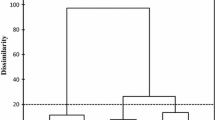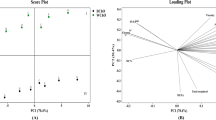Abstract
Walnut oil is in great demand due to its high nutritional value. However, it is easily oxidized and often loses its typical flavor. This study focused on the role of microwave pretreatment in improving the flavor and oxidative stability of walnut oil, and also investigated the effects of microwave pretreatment on unsaturated fatty acids (oleic, palmitoleic, linoleic, and linolenic acids) and antioxidant components (tocopherols and phytosterols). The results indicate that microwave pretreatment is effective in generating pyrazine compounds. The typical ‘roasted’ flavor was present when pretreatment for 2 min or more was applied. Meanwhile, compared with the control sample, only the highly treated sample (microwave-pretreated for 4 min) showed higher oxidative stability. Only small changes were found in the composition of the unsaturated fatty acids, while the levels of tocopherols and phytosterols significantly decreased with increasing duration of microwave treatment (P < 0.05). The results suggest that the Maillard reaction caused the improvement of oxidative stability, since this reaction can also generate antioxidant products (melanoidins) in addition to pyrazines. Moreover, microwave pretreatment was found to be effective for enhancing the oil yield during pressing. Therefore, despite its adverse effects on tocopherols and phytosterols, microwave pretreatment could be used to improve the flavor and oxidative stability of walnut oil.




Similar content being viewed by others
References
Martínez ML, Mattea MA, Maestri DM (2006) Varietal and crop year effects on lipid composition of walnut (Juglans regia) genotypes. J Am Oil Chem Soc 83(9):791–796
Martínez ML, Labuckas DO, Lamarque AL, Maestri DM (2010) Walnut (Juglans regia L.): genetic resources, chemistry, by-products. J Sci Food Agric 90(12):1959–1967
Food and Agriculture Organization (2015) FAOSTAT data. FAO, Rome
Gharibzahedi SMT, Mousavi SM, Hamedi M, Khodaiyan F (2014) Determination and characterization of kernel biochemical composition and functional compounds of Persian walnut oil. J Food Sci Technol 51(1):34–42
Pereira JA, Oliveira I, Sousa A, Ferreira IC, Bento A, Estevinho L (2008) Bioactive properties and chemical composition of six walnut (Juglans regia L.) cultivars. Food Chem Toxicol 46(6):2103–2111
Greve LC, McGranahan G, Hasey J, Snyder R, Kelly K, Goldhamer D, Labavitch JM (1992) Variation in polyunsaturated fatty acids composition of Persian walnut. J Am Soc Hortic Sci 117(3):518–522
Azadmard-Damirchi S, Alirezalu K, Achachlouei BF (2011) Microwave pretreatment of seeds to extract high quality vegetable oil. World Acad Sci Eng Technol 57:72–75
Nyam KL, Tan CH, Long K (2015) Effect of microwave pretreatment on stability of kenaf (Hibiscus cannabinus L.) seed oil upon accelerated storage. Int Food Res J 22:1898–1905
Yang M, Huang F, Liu C, Zheng C, Zhou Q, Wang H (2013) Influence of microwave treatment of rapeseed on minor components content and oxidative stability of oil. Food Bioprocess Technol 6(11):3206–3216
Uquiche E, Jeréz M, Ortíz J (2008) Effect of pretreatment with microwaves on mechanical extraction yield and quality of vegetable oil from Chilean hazelnuts (Gevuina avellana Mol). Innov Food Sci Emerg Technol 9(4):495–500
Anjum F, Anwar F, Jamil A, Iqbal M (2006) Microwave roasting effects on the physico–chemical composition and oxidative stability of sunflower seed oil. J Am Oil Chem Soc 83(9):777–784
Ames JM (1990) Control of the Maillard reaction in food systems. Trends Food Sci Technol 1:150–154
Smith AL, Perry JJ, Marshall JA, Yousef AE, Barringer SA (2014) Oven, microwave, and combination roasting of peanuts: comparison of inactivation of salmonella surrogate Enterococcus faecium, color, volatiles, flavor, and lipid oxidation. J Food Sci 79(8):S1584–S1594
Liu X, Jin Q, Liu Y, Huang J, Wang X, Mao W, Wang S (2011) Changes in volatile compounds of peanut oil during the roasting process for production of aromatic roasted peanut oil. J Food Sci 76(3):C404–C412
Kiralan M (2012) Volatile compounds of black cumin seeds (Nigella sativa L.) from microwave-heating and conventional roasting. J Food Sci 77(4):C481–C484
Jung MY, Bock JY, Baik SO, Lee JH, Lee TK (1999) Effects of roasting on pyrazine contents and oxidative stability of red pepper seed oil prior to its extraction. J Agric Food Chem 47(4):1700–1704
National Standard of the PRC (GB/T 22460-2008, ISO15305:1998, IDT): Animal and vegetable fats and oils-Determination of Lovibond colour. Beijing, China
AOCS (1997) Oven storage test for accelerated aging of oils, in Official Methods and Recommended Practices of the AOCS. AOCS Press, Champaign, pp 5–97
National Standard of the PRC (GB/T 5538-2005, ISO3960:2001, IDT): Animal and vegetable fats and oils-Determination of peroxide value. Beijing, China
National Standard of the PRC (GB/T 24304-2009, ISO6885:2006, IDT): Animal and vegetable fats and oils-Determination of anisidine value. Beijing, China
Savage GP, Dutta PC, McNeil DL (1999) Fatty acid and tocopherol contents and oxidative stability of walnut oils. J Am Oil Chem Soc 76(9):1059–1063
National Standard of the PRC (GB/T 5532-2008, ISO3961:1996, MOD): Animal and vegetable fats and oils-Determination of iodine value. Beijing, China
Arranz S, Cert R, Pérez-Jiménez J, Cert A, Saura-Calixto F (2008) Comparison between free radical scavenging capacity and oxidative stability of nut oils. Food Chem 110(4):985–990
NP EN ISO 12228 (1999) Animal and vegetable fats and oils-Determination of individual and total sterols contents-Gas chromatographic method
Jung MY, Bock JY, Back SO, Lee TK, Kim JH (1997) Pyrazine contents and oxidative stabilities of roasted soybean oils. Food Chem 60(1):95–102
Van Boekel MAJS (2006) Formation of flavour compounds in the Maillard reaction. Biotechnol Adv 24(2):230–233
Amrani-Hemaimi M, Cerny C, Fay LB (1995) Mechanisms of formation of alkylpyrazines in the Maillard reaction. J Agric Food Chem 43(11):2818–2822
Serpen A, Gökmen V (2009) Evaluation of the Maillard reaction in potato crisps by acrylamide, antioxidant capacity and color. J Food Compos Anal 22(6):589–595
Lin JT, Liu SC, Hu CC, Shyu YS, Hsu CY, Yang DJ (2016) Effects of roasting temperature and duration on fatty acid composition, phenolic composition, Maillard reaction degree and antioxidant attribute of almond (Prunus dulcis) kernel. Food Chem 190:520–528
Liu Y, Kitts DD (2011) Confirmation that the Maillard reaction is the principle contributor to the antioxidant capacity of coffee brews. Food Res Int 44(8):2418–2424
Crews C, Hough P, Godward J, Brereton P, Lees M, Guiet S, Winkelmann W (2005) Study of the main constituents of some authentic hazelnut oils. J Agric Food Chem 53(12):4843–4852
Martínez ML, Maestri DM (2008) Oil chemical variation in walnut (Juglans regia L.) genotypes grown in Argentina. Eur J Lipid Sci Technol 110(12):1183–1189
Momchilova S, Nikolova-Damyanova B (2007) Quantitative TLC and gas chromatography determination of the lipid composition of raw and microwaved roasted walnuts, hazelnuts, and almonds. J Liq Chromatogr Relat Technol 30(15):2267–2285
Knothe G (2002) Structure indices in FA chemistry. How relevant is the iodine value? J Am Oil Chem Soc 79(9):847–854
Yoshida H, Kajimoto G (1994) Microwave heating affects composition and oxidative stability of sesame (Sesamum indicum) oil. J Food Sci 59(3):613–616
Yoshida H, Hirakawa Y, Abe S, Mizushina Y (2002) The content of tocopherols and oxidative quality of oils prepared from sunflower (Helianthus annuus L.) seeds roasted in a microwave oven. Eur J Lipid Sci Technol 104(2):116–122
Venkatesh MS, Raghavan GSV (2004) An overview of microwave processing and dielectric properties of agri-food materials. Biosyst Eng 88(1):1–18
Kris-Etherton PM, Taylor DS, Yu-Poth S, Huth P, Moriarty K, Fishell V, Etherton TD (2000) Polyunsaturated fatty acids in the food chain in the United States. Am J Clin Nutr 71(1):179S–188S
Li L, Tsao R, Yang R, Kramer JK, Hernandez M (2007) Fatty acid profiles, tocopherol contents, and antioxidant activities of heartnut (Juglans ailanthifolia var. cordiformis) and Persian walnut (Juglans regia L.). J Agric Food Chem 55(4):1164–1169
Bada JC, León-Camacho M, Prieto M, Copovi P, Alonso L (2010) Characterization of walnut oils (Juglans regia L.) from Asturias, Spain. J Am Oil Chem Soc 87(12):1469–1474
Lea CH, Ward RJ (1959) Relative antioxidant activities of the seven tocopherols. J Sci Food Agric 10(10):537–548
Huang SW, Frankel EN, German JB (1995) Effects of individual tocopherols and tocopherol mixtures on the oxidative stability of corn oil triglycerides. J Agric Food Chem 43(9):2345–2350
Winkler JK, Warner K (2008) Effect of phytosterol structure on thermal polymerization of heated soybean oil. Eur J Lipid Sci Technol 110(11):1068–1077
Lavedrine F, Ravel A, Poupard A, Alary J (1997) Effect of geographic origin, variety and storage on tocopherol concentrations in walnuts by HPLC. Food Chem 58(1):135–140
Author information
Authors and Affiliations
Corresponding author
About this article
Cite this article
Zhou, Y., Fan, W., Chu, F. et al. Improvement of the Flavor and Oxidative Stability of Walnut Oil by Microwave Pretreatment. J Am Oil Chem Soc 93, 1563–1572 (2016). https://doi.org/10.1007/s11746-016-2891-9
Received:
Revised:
Accepted:
Published:
Issue Date:
DOI: https://doi.org/10.1007/s11746-016-2891-9




